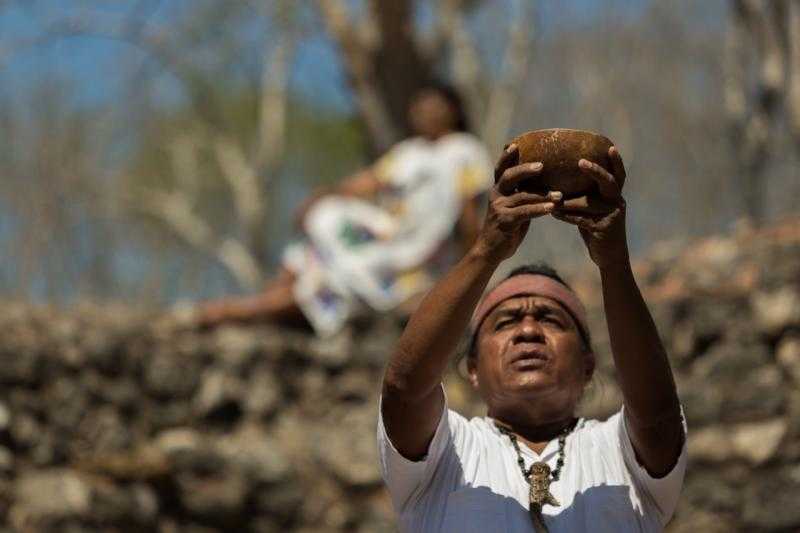Chaltún Há, an archaeological zone within the Magical Town of Izamal, opens its doors

- The Sefotur together with the City Council of Izamal and the INAH inaugurate the site, as part of the actions to increase the tourist offer of the state.
-Michelle Fridman Hirsch endorses her commitment to continue working for sustainable, responsible and inclusive tourism, for the benefit of Yucatecans.
Izamal, Yucatán, April 23, 2019.- This morning the archaeological zone of Chaltún Há (flat stone where water is collected), a Mayan vestige located within the Magical Town of Izamal, opened its doors, as part of the actions undertaken by the Tourism Development Secretariat (Sefotur) to attract more visitors and increase the attractions of the so-called City of Three Cultures.
This site was formally inaugurated by the National Institute of Anthropology and History (INAH) in conjunction with the Izamal City Council and the agency, whose head, Michelle Fridman Hirsch, joined the celebration with the opening of the white path or Sac Bé, which It will allow the public to enter such an important venue, which will set a precedent in the history of this municipality.
Accompanied by the host mayor, Fermín Sosa Lugo, as well as the director and co-director of the Izamal archaeological project, Luis Millet and Rafael Burgos Villanueva, respectively, the latter being represented by the head of INAH, Eduardo López Calzada, the official emphasized the decentralization of tourism with the aim of promoting greater benefits for Yucatan and its inhabitants.
"One of Governor Mauricio Vila Dosal's assignments is the decentralization of tourism so that it becomes an engine of social and economic development for Yucatan and the Yucatecans, for this reason, we have been working with each of the municipalities in a very important way, and especially with Izamal, the first Magical Town of Mexico, which also has enormous tourism potential," he said.
In turn, Fridman Hirsch recalled the Consultation Forums "Towards sustainable tourism" that took place in Valladolid, Mérida and Izamal, where the central theme was sustainability as a line of action that allows tourism to be brought to carried out responsibly, with inclusion and above all, that manages to preserve natural resources, culture and heritage.
"Tourism must be of and for all Yucatecans, that everyone can enjoy it, but, above all, that everyone benefits and that identity be strengthened, because it is also about preserving the assets that Yucatan has, being one of the most beautiful places in the world" he declared before the Legal Chief of INAH, José Arturo Chab Cárdenas.
For his part, Sosa Lugo pointed out that the opening of Chaltún Há is the result of joint work and commitment between the different government agencies, with the aim of providing comfortable and safe access for tourism to increase, as well as benefits for citizens.
"Izamal for me is the best tourist spot in the entire state, it is the most beautiful thing we have and I am very happy to be here serving the citizens and the people who visit us" he endorsed in front of the president of the System for the Integral Development of the Municipal Family (DIF), Seidy Azcorra Rosado.
Meanwhile, Chab Cárdenas stressed that Izamal is not only gradually recovering its pre-Hispanic splendor, but also by formally opening the doors of this attraction, within the framework of INAH's 80th anniversary, safeguarding and preserving the heritage of Mexico.
"It implies not only the opening of an area but also a series of institutional efforts between various dependencies of the public administration, in order to provide security, cleanliness and surveillance to this archaeological center and thus also continue with the investigation of the area that is not completely restored and to continue giving Izamal the place it deserves because it is a privileged place," he emphasized.
For this achievement, various actions were carried out, among which a new access to the site, general cleaning of the pyramid and signage stand out. The works were carried out by personnel from INAH and the Izamal City Council, as part of the Izamal archaeological and historical project.
During the event, it was announced that the land on which the venue is located will be donated to the federation by Carlos Molina Medina from Izamal, with the aim of integrating it into the rescue plan. Chaltún Há is the fourth monolithic structure of 12 that exist in the municipality, where there are also a total of 168 pre-Hispanic vestiges.
It is located approximately one kilometer south of the core of the Izamal settlement. This structure is a large platform three meters high, on which there are three buildings, while two other smaller ones are located on the east and west sides. The main one is six meters high and is located on the south side.
Attached to this building on the south side, there is another basement one meter high, on which three settlements are located, possibly residential, built with perishable materials.
Structure 23 or Chaltún Há had possible administrative functions by serving as an intermediate point between the periphery and the core of the pre-Hispanic city, to which it was connected through a Sac Bé.
The recovered ceramic materials indicate a chronology for the Terminal Classic (900-1200 AD), although it is not ruled out that activities were carried out in earlier times in earlier parts of this space.
After announcing that the site will be open from Monday to Sunday, from 8:00 a.m. to 5:00 p.m., Fridman Hirsch highlighted the excellent results in tourism that he reg
Archeology